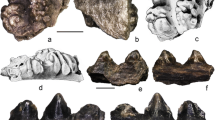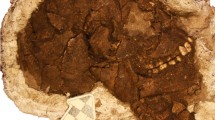Abstract
Based on results of the comparison of skull proportions and using available data on phylogeny of barbins we discuss patterns of morphological diversity of the present forms and modes of morphological transformations resulting in their emergence. There is no strict correspondence between distance in a character space and genealogical closeness of forms. Similar forms of barbins independently originated from a generalized form in different sites of Africa and western Asia. Regularity of patterns of morphological diversity is thought to be caused by the ‘channeling’ of morphological transformations. Heterochrony played an important part in evolution of the African ‘large Barbus’ and Varicorhinus. Extraordinary morphological diversity of the African barbins, Lake Tana barbs in particular, is caused mainly by drastic changes in patterns of relative growth late in ontogeny.
Similar content being viewed by others
References
Alberch, P., S.J. Gould, G.F. Oster & D.B. Wake. 1979. Size and shape in ontogeny and phylogeny. Paleobiology 5: 296–317.
Alekseyev, S.S., Y.Y. Dgebuadze, M.V. Mina & A.N. Mironovsky. 1996. Small ‘large barbs’ spawning in tributaries of Lake Tana: what are they? Folia Zool. 45(suppl.1): 85–96.
Banister, K.E. 1973. A revision of the large Barbus (Pisces, Cyprinidae) of East and Central Africa. Studies of African Cyprinidae. Part II. Bull. British Museum Natural History (Zoology) 26: 1–148.
Banister, K.E. 1984. Three new species of Varicorhinus (Pisces, Cyprinidae) from Africa. Bull. British Museum Natural History (Zoology) 47: 273–282.
Berg, L.S. 1914. Fishes (Marsipobranchia and Pisces). Fauna Rossii i sopredelnykh stran 3: 1–336 (in Russian).
Berrebi, P., M. Kottelat, P. Skelton & P. Rab. 1996. Systematics of Barbus: state of art and heuristic comments. Folia Zool. 45(suppl. 1): 5–12.
Cock, A.G. 1966. Genetical aspects of metrical growth in animals. Quart. Rev. Biol. 41: 131–190.
deGraaf, M., E. Dejen, F.A. Sibbing & J.W.M. Osse. 2000. Barbus tanapelagicus, a new species from Lake Tana (Ethiopia): its morphology and ecology. Env. Biol. Fish. 59: 1–9.
Dgebuadze, Y.Y, M.V. Mina, S.S. Alekseyev & A.S. Golubtsov. 1999. Observations on reproduction of the Lake Tana barbs. J. Fish Biol. 54: 417–423.
Fishelson, L, M. Goren, J. van Vuren & R. Manelis. 1996. Some aspects of the reproductive biology of Barbus spp., Capoeta damascina and their hybrids (Cyprinidae, Teleostei) in Israel. Hydrobiologia 371: 79–88.
Golubtsov, A.S. 1993. Biogéoraphie des ‘grands Barbus’ d’ É'thiopie avec référence spéciale à des formes à status taxinomiques incertains. Cahiers d'Ethologie 13: 227–230.
Golubtsov, A.S & E.Y. Krysanov. 1993. Karyological study of some cyprinid species from Ethiopia. The ploidy differences between large and small Barbus of Africa. J. Fish Biol. 42: 445–455.
James, F.C. & C.E. McCulloch. 1990. Multivariate analysis in ecology and systematics: panacea or Pandora's box? Ann. Rev. Ecol. Syst. 21: 129–166.
Karaman, M.S. 1971. Süsswasserfishe der Türkei. 8. Teil. Revision der Barben Europas, Vorderasien und Nordafrikas. Mitteilungen aus dem Hamburgischen Zoologischen Museum und Institut 67: 175–254.
Kosswig, C. & W. Villwock. 1965. Das Problem der intralakustrischen Speziation im Titicaca - und Lanaosee. Zool. Anzeiger 28. (Supplementband): 95–101.
Krupp, F. 1985. Barbus continii Vinciguerra, 1926, a possible natural hybrid of Barbus canis and Barbus longiceps (Pisces: Osteichthyes: Cyprinidae). Senckenbergiana Biologica 66(1/3): 9–15.
Krysanov, E.Y. 1999. Karyotypes of Varicorhinus capoeta and Barbus goktschaicus (Cypriniformes) from Lake Sevan (Armenia).J. Ichthyol. 39: 187–189.
Krysanov, E.Y. & A.S. Golubtsov. 1996. Karyotypes of some Ethiopian Barbus and Varicorhinus from the Nile basin including Lake Tana morphotypes. Folia Zool. 45(suppl. 1): 67–75.
McNamara, K.J. 1986. A guide to the nomenclature of heterochrony. J. Paleontol. 60: 4–13.
Mina, M.V. 1991. Microevolution of fishes: evolutionary aspects of phenetic diversity. Amerind. New Dehli. 215 pp.
Mina, M., A. Mironovsky & Y. Dgebuadze. 1993. Allométrie et divergence entre les barbeaux du lac Tana (Ethiopie). Cahiers d'Ethologie 13: 219–222.
Mina, M.V., A.N. ironovsky & Y.Y. Dgebuadze. 1996a. Lake Tana large barbs: phenetics, growth and diversification. J. Fish Biol. 48: 383–404.
Mina, M.V., A.N. Mironovsky & Y.Y. Dgebuadze. 1996b. Morphometry of barbel of Lake Tana, Ethiopia: multivariate ontogenetic channels. Folia Zool. 45(suppl. 1): 109–116.
Mina, M.V., A.N. Mironovsky, A.S. Golubtsov & Y.Y. Dgebuadze. 1998. The ‘Barbus’ intermedius species flock in Lake Tana (Ethiopia): II. Morphological diversity of ‘large barbs’ from Lake Tana and neighboring areas: homoplasies or synapomorphies? Italian J. Zool. 65(suppl.): 9–14.
Mir, S., A. Al-Absy & F. Krupp. 1988. A new natural intergeneric cyprinid hybrid from Jordan River drainage, with a key to the large barbine cyprinids of the southern Levant. J. Fish Biol. 32: 931–936.
Nagelkerke, L.A.J., F.A. Sibbing & J.W.M. Osse. 1995. Morphological divergence during growth in the large barbs (Barbus spp.) of Lake Tana, Ethiopia. Neth. J. Zool. 45: 431–454.
Nagelkerke, L.A.J. & F.A. Sibbing. 1996. Reproductive segregation among the Barbus intermedius complex of Lake Tana, Ethiopia.Anexample of intralacustrine speciation? J. Fish Biol. 49: 1244–1266.
Nagelkerke, L.A.J. & F.A. Sibbing. 1997. A revision of the large barbs (Barbus spp., Cyprinidae, Teleostei) of Lake Tana, Ethiopia, with a description of seven new species. pp. 105–170. In: The Barbs of Lake Tana, Ethiopia: Morphological Diversity and Its Implications for Taxonomy, Trophic Resource Partitioning and Fisheries, Ph.D. Thesis, Agricultural University Wageningen, Wageningen.
Nagelkerke, L.A.J. & F.A. Sibbing. 2000. The large barbs (Barbus spp. Cyprinidae, Teleostei) of Lake Tana (Ethiopia), with a description of a new species, Barbus osseensis. Neth. J. Zool. 50: 79–214.
Nagelkerke, L.A.J., F.A. Sibbing, J.G.M. van den Boogaart, E.H.R.R. Lammens & J.W.M. Osse. 1994. The barbs (Barbus spp.) of Lake Tana: a forgotten species flock? Env. Biol. Fish. 39: 1–21.
Oellermann, L.K. & P.H. Skelton. 1990. Hexaploidy in yellow-fish species (Barbus, Pisces, Cyprinidae) from southern Africa. J. Fish Biol. 37: 105–115.
Rab, P.,Y. Karakousis & M. Rabov´a. 1996. Karyotype, NOR phenotype and C-banding study of Barbus cyclolepis from Greece. Folia Zool. 45 (suppl. 1): 77–83.
Reig, S., I. Doadrio & A.N. Mironovsky. 1998. Geometric analysis of size and shape variation in barbel from Lake Tana (Ethiopia). Folia Zool. 47 (suppl.1): 35–51.
Sibbing, F.A, L.A.J. Nagelkerke, R.M. Stet & J.W.M. Osse. 1998. Speciation of endemic Lake Tana barbs (Cyprinidae, Ethiopia) driven by trophic resource partitioning; a molecular and ecomorphological approach. Aquat. Ecol. 32: 217–227.
Steinitz, H. & A. Ben-Tuvia. 1957. The hybrid of Barbus longiceps C.V. andVarhicorhinus damascinus C.V. (Cyprinidae, Teleostei). Bull. Res. Counc. Israel 6B: 176- 188.
Stoumboudi, M.T. & M. Abraham. 1996. The spermatogenetic process in Barbus longiceps, Capoeta damascina and their natural sterile hybrid (Teleostei, Cyprinidae). J. Fish Biol. 49: 458–468.
Vasil'ev, V.P. 1985. Evolutionary karyology of fishes. Nauka Press, Moscow. 300 pp. (in Russian).
Author information
Authors and Affiliations
Rights and permissions
About this article
Cite this article
Mina, M.V., Mironovsky, A.N. & Golani, D. Consequences and Modes of Morphological Diversification of East African and Eurasian Barbins (genera Barbus, Varicorhinus and Capoeta) with Particular Reference to Barbus Intermedius Complex. Environmental Biology of Fishes 61, 241–252 (2001). https://doi.org/10.1023/A:1010952108081
Issue Date:
DOI: https://doi.org/10.1023/A:1010952108081




